I’m just back from a pleine aire, oil painting workshop and it seems that my topic — to paint in the middle in the muddle or to recollect in tranquility — has arisen again on A&P. Hi Sunil…..
Obviously I’m fascinated with the immediate ambiance as much as I am with the final product. The milieu from which I just returned, however, had its problems. The big one was the lack of focus within the landscapes we were asked to paint. So the topic of the day is — how do you find your viewpoints and hold them?Even you, Sunil, must have a focus, an idea of “character” that you are working toward. That was the big question which the landscape I just painted held for me — what do I choose to paint and why.
The workshop was held in Diamond, Oregon, back of the outback, southeastern Oregon, where cows and rattlesnakes outnumber the humans and the coyotes outnumber all. It’s range land verging on desert. Parts of it are desert.
The hamlet of Diamond has a population of 5, as well as a hotel, 8 rooms to let, baths down the hall, fantastic dinners, good innkeepers, in the middle of nowhere.
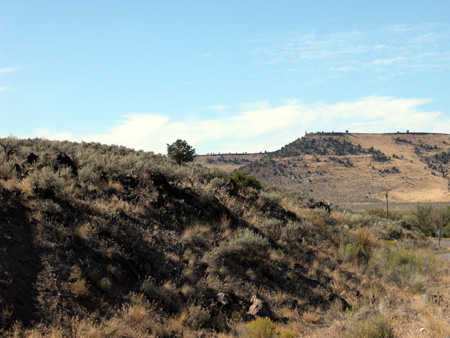
This photo, taken across the road from the hotel, is a sample of the kind of landscape we were to paint.
The first day we got started late — the caravan left at 8 AM and stopped at the view below. Jef Gunn, the instructor, said he chose this spot because it was “easy.” (Actually the view is much much much wider than what my camera would permit me to depict — imagine 5 or 6 more photos set up side by side, all of which look pretty much like this one).
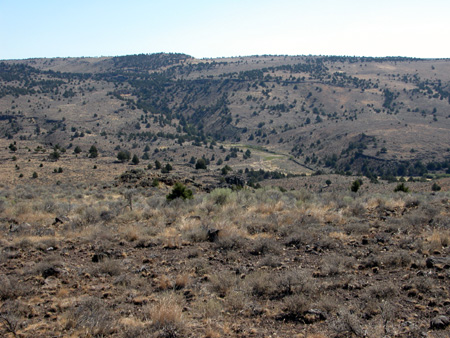
I chose the ravine but captured nothing but sunburn.
The next day we left at 6 AM, to catch the shadows. Or, as I quickly learned, “to chase the shadows.”
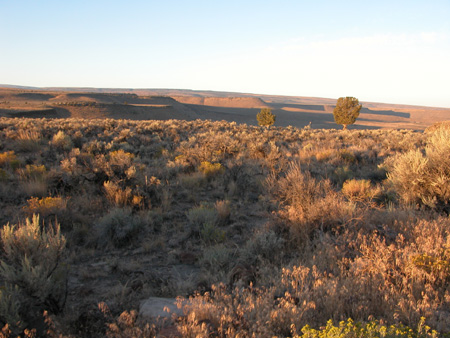
It is true that the scene was charming in the early sun. But one still had to paint it. I quickly got confused because every time I pinned down a spot to paint, a shadow changed and I lost my place. I finally painted a painting of a landscape, some landscape, but clearly not this landscape. This is how the scene looked some hours later — the gear is mine.
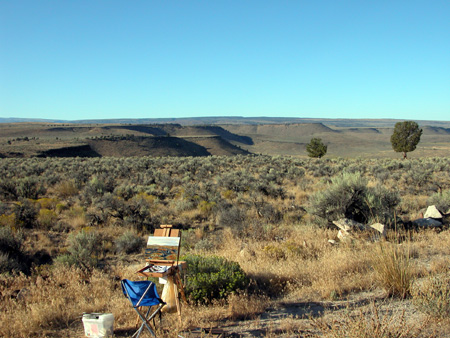
our biggest excursion and presumably the biggest challenge was set for the last full day of the workshop. It entailed driving about 60 miles (half on gravel roads) to Steen’s Mountain, a great escarpment, uplifted, which on its eastern side falls abruptly 5000 feet to the Alvord desert below.
Before we reached the top of Steen’s, however, in a glacier-scoured bowl off one of the sides of the uplift, Kiger Gorge drops, sending its icy waters back west to Diamond. We weren’t permitted to paint there as there was only one thing, according to Herr Gunn, to paint. Too easy, he said.
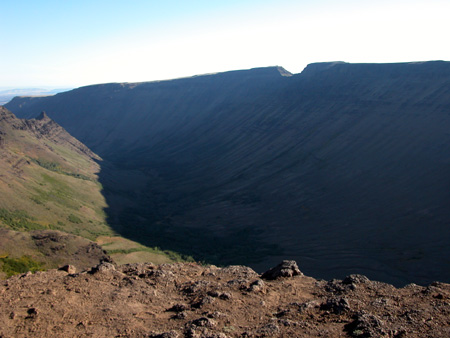
Further up the gravel road was the top of Steen’s Mountain, where the uplift found its downside. The wind was blowing hard, the dust was furious in our eyes, and the sun blazing hot. I found a spot in front of Jef’s pick-up truck, hunkered down, painted with the canvas flat so it wouldn’t turn into a sail, and did the best painting I had done all week. Here’s the view, hasty photos taken when we first arrived.
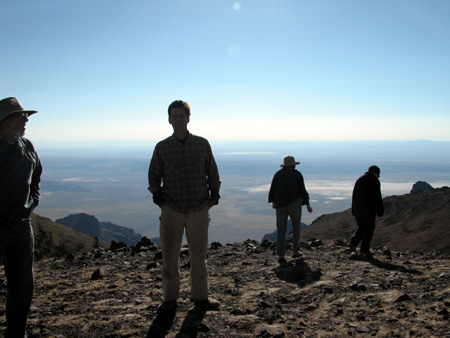 center
center
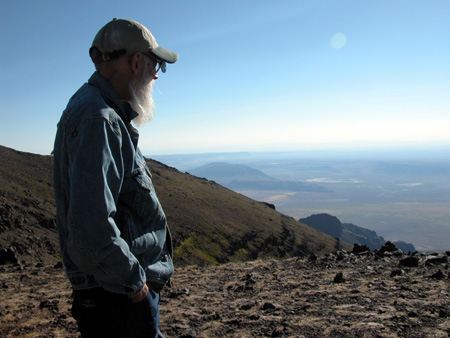 left
left
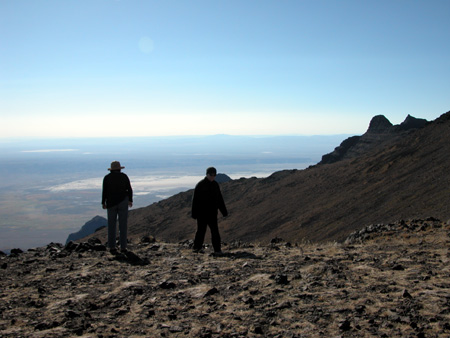 right
right
I painted right down the center, using the triangles of the sides as ways into the canvas. At least that’s what I think I did. I haven’t looked at the canvas since the critique, held when we returned from Steens.
What astonished me most was that a landscape which I would have said had no focus came into focus once I had to find one.
Has this happened to you? Is it easier to paint human characters than undifferentiated landscapes, not because of the rain and wind but because of the indifference of nature to meaning? Does the necessity of finding a focus or a point of view bring one about? These are not questions to which I have answers.
I haven’t yet unpacked the paintings and thus don’t have photos of them. My recollection is that I got 3, perhaps 4, decent paintings from the 8 I did in that 3 1/2 days. But I’m not sure what I learned is encompassed in any of them. Tomorrow I guess I’ll unpack.

June,
Your experience is very familiar to me. I’m still bad at developing good pictures from this western landscape. I tend to cop out most of the time by going smaller scale to more intimate landscapes, but I am trying to get better at the larger scale. A key factor seems to be simply time: I have to be in a place for a while to understand what it offers me. And it’s hard to make that time. A workshop like yours is a great way to do it.
Going through that process of finding you focus is one of the best parts of the experience for me. That’s when I’m really engaging with the landscape in situ, as Karl wrote about recently.
I look forward to seeing your paintings, and hearing about your thoughts on them after some time has passed. You may like some of your successes less, and you may appreciate better some you now think of as second-rate.
Steve,
It’s interesting that finding a focus and “engaging” seem to go together. I agree with you that they do, that the undifferentiated mass of land has to be sorted by the viewing eye a bit. A mind has to make a shift from seeing an indiscriminate mass to something meaningful. Sometimes the meaning is found to be the shadows, sometimes the form of the rock at your feet, but whatever kinds of “sorting” works, it’s best when I have a thoroughly engaged mind vis-a-vis an unsorted landscape. An already sorted landscape doesn’t capture my attention so well, and so I have found that I want to stay away from the scenes with roads winding through them or tidy fields laid out in pleasing geometrics. Those I’m not as fond of painting as I am of the muckled miserable lumps that some of eastern Oregon present.
By the way, I just looked briefly at my paintings as I unpacked them, and I’m a bit surprised.
Hello June:
Things look high and dry over there in Diamond.
It’s that implacable sky. It is such a presence for being such an absence. I would suppose that, painting from an elevated position and looking down, one can reduce or eliminate the sky. But setting up at the hotel, and seeing what your photograph shows, would obligate one to deal with it.
I look forward to seeing your paintings.
The indifference of nature to meaning is sometimes seen in the face of the cast of characters that I work on. It is everywhere, but a face offers a little more focus at times especially if it has a story to tell you. Interesting questions that you have raised there – June – made me take out my son to a nearby county park this weekend and trek down a very isolated trail. After we sat under the dark shadow of a large pine tree I told my three year old son to do nothing but listen to the wind through the trees. I closed my eyes for a second trying to enjoy the quiet dark peace and opened my eyes to see a pine cone stuck to my son’s right hand with a lot of the sticky pine sap on his other hand – he obviously had a different idea of exploring the landscape.
It will be interesting to see your most recent explorations in Diamond.
What astonished me most was that a landscape which I would have said had no focus came into focus once I had to find one.
June, excellent point. Looking at a landscape (or anything) while painting always gives me a deeper appreciation than ordinary looking. But it takes some time to get into. Recently I spent several hours in the dunes making charcoal sketches on canvas as preparation for a painting. I kept doing more or less the same scene again and again and again. I eventually got it right, but it would have been easy to give up. I just told myself that I was not used to drawing this scenery and I needed to learn the language of the rolling forms.
Karl,
Your comments mirror my own observations of how my paintings improved over those intense four days of work. The landscape didn’t change — I did.
I’m not a student or former student, just an aging watercolorist. Reportedly our grandfather, Emmet, ran cattle as a young man for Pete French in the 80s out of Frenchglen, across the Steens,to the railhead in Winnemucca (maybe once, maybe many times). A lonely trail and we have a few stories. I’ve always dreamed of what you did having seen the country from several sides, and once even dragged the family to the “hotel” in Frenchglen for homebaked bread and ham sandwiches and apple pie. Hope they’re still in business. Pete died a cattleman’s death, and the family settled in Condon. Seeing those views over time might have an effect, but how do you find the focus? Cattle, horses or people might do it, but when they are missing give me a wrecked old building or something – staying away from birds. Thank you for tolerating my intrusion.